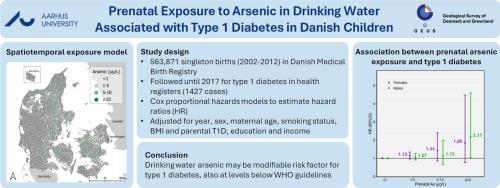产前暴露于饮用水中的砷和1型糖尿病在全国人口为基础的队列丹麦儿童
IF 9.7
1区 环境科学与生态学
Q1 ENVIRONMENTAL SCIENCES
引用次数: 0
摘要
怀孕期间暴露于无机砷与免疫失调和白细胞亚群的转移有关,这与1型糖尿病(T1D)的发病机制密切相关。目的探讨丹麦儿童产前饮水砷暴露与自身免疫性疾病T1D的关系。方法从丹麦国家患者和处方登记中,将产前家庭饮用水砷暴露与T1D诊断信息联系起来。2002年至2012年,所有来自丹麦出生医疗登记处的单胎出生,以及生活在使用公共供水的家庭中,都被纳入其中。Cox比例风险模型以年龄为基础时间尺度,并根据历年、出生性别、母亲年龄、吸烟状况、BMI、父母T1D状况、教育程度和收入进行调整。结果在563,871例新生儿中,观察到产前砷饮用水暴露与T1D呈正相关。在以 <; 1µg/L为参考的完全调整模型中,观察到单调增加的相关性,HR(95 % CI)分别为1 - 5、5-10和 ≥ 10 µg/L: 1.10(0.98-1.24)、1.29(0.88-1.87)和2.04(1.15-3.60)。在所有暴露类别中,与出生体重中位数以下的儿童相比,在出生体重中位数以上的儿童中观察到更高的风险。据我们所知,这是第一个调查产前砷暴露与T1D之间关系的研究。我们发现,怀孕期间饮用水中砷含量低会增加公共供水用户患T1D的风险,突出表明砷是T1D的潜在可改变风险因素。本文章由计算机程序翻译,如有差异,请以英文原文为准。


Prenatal exposure to arsenic in drinking water and type 1 diabetes in a nationwide population-based cohort of Danish children
Background
Exposure to inorganic arsenic during pregnancy has been associated with immune dysregulation and shifts in leukocyte subpopulations critically involved in the pathogenesis of type 1 diabetes (T1D).
Objectives
This study explores the association between prenatal drinking water arsenic exposure and the autoimmune disease T1D in Danish children.
Methods
Prenatal arsenic exposure from household drinking water was linked with information on T1D diagnoses from The Danish National Patient- and Prescription Registries. All singleton births from 2002 to 2012, located from The Danish Medical Birth Registry, and living in a household using a public water supply, were included. Cox proportional hazards models were used with age as underlying time scale and adjusted for calendar year, sex at birth, maternal age, smoking status, BMI, parental T1D status, education and income.
Results
In a total of 563,871 births, a positive association between prenatal arsenic drinking water exposure and T1D was observed. In fully adjusted models using <1 µg/L as reference, a monotonically increasing association was observed, HR (95 % CI): 1.10 (0.98–1.24), 1.29 (0.88–1.87) and 2.04 (1.15–3.60) for 1–5, 5–10, and ≥10 µg/L, respectively. A higher risk was observed among children born above median compared with below median birth weight across all exposure categories.
Discussion
To our knowledge, this is the first study to investigate the association between prenatal arsenic exposure from drinking water and T1D. We found that low levels of arsenic during pregnancy increased risk of T1D in public supply users, highlighting arsenic as a potential modifiable risk factor for T1D.
求助全文
通过发布文献求助,成功后即可免费获取论文全文。
去求助
来源期刊

Environment International
环境科学-环境科学
CiteScore
21.90
自引率
3.40%
发文量
734
审稿时长
2.8 months
期刊介绍:
Environmental Health publishes manuscripts focusing on critical aspects of environmental and occupational medicine, including studies in toxicology and epidemiology, to illuminate the human health implications of exposure to environmental hazards. The journal adopts an open-access model and practices open peer review.
It caters to scientists and practitioners across all environmental science domains, directly or indirectly impacting human health and well-being. With a commitment to enhancing the prevention of environmentally-related health risks, Environmental Health serves as a public health journal for the community and scientists engaged in matters of public health significance concerning the environment.
 求助内容:
求助内容: 应助结果提醒方式:
应助结果提醒方式:


